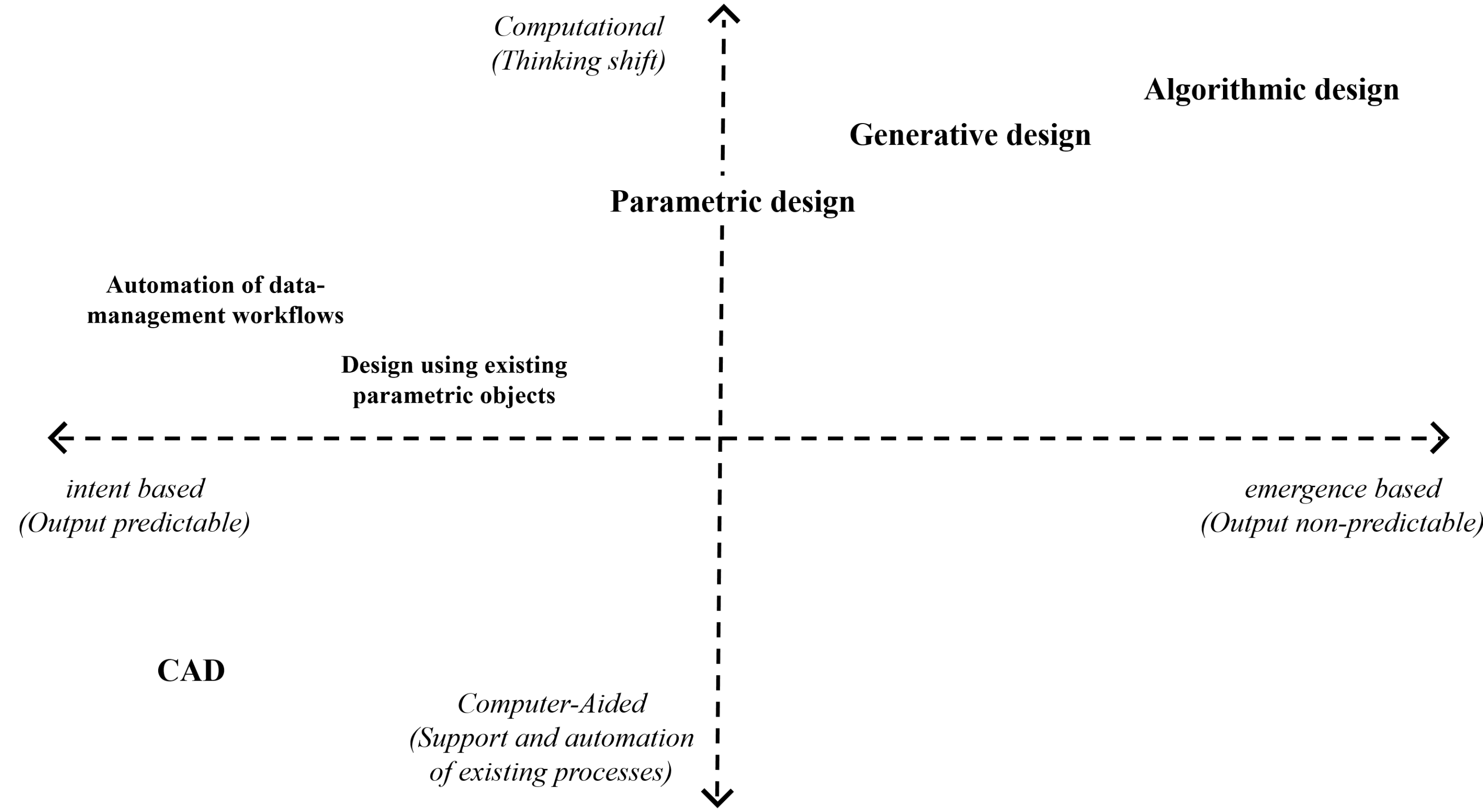Through the ever-increasing speed and capacity of computers, computation enables dealing with tasks that were traditionally either too time-consuming or too challenging to be accomplished sustainably by humans alone. However, computation is not just about automating traditional processes or tedious activities; it’s about shifting the way we think and design.
To learn more about computational design, please refer to the chapter “Introduction to Computational Design: Subsets, Challenges in Practice and Emerging Roles” by the author as part of a Springer book Industry 4.0 for the Built Environment, edited by Marzia Bolpagni, Rui Gavina, and Diogo Rodrigo Ribeiro.
“Computational” is not “Computer-aided,” and why it’s important.
As early as in the 1960s, researcher and visionary Nicholas Negroponte highlighted the distinction between “computer-aided,” which is about traditional processes supported by computation tools, and “computerized,” or “digitalized,” which is about new processes enabled by computers. Later on, in the 2000s, Kostas Terzidis went one step further with the term “computational,” highlighting the distinction between the uses of the technique (the computers, as in computer-aided or digitalized) and the uses of the thinking paradigm (the computation, as in computational design).
This distinction emphasizes that employing computational design requires, first and foremost, a change in mindset rather than a simple application of digital tools to an existing design or process. In other words, “Algorithms are used, not to enhance architectural designs, but rather to conceive them”[1].
[1] Terzidis, K. Algorithmic Design: A Paradigm Shift in Architecture? in Proceedings of the 22nd eCAADe Conference 201–207 (2004).
Parametric, Generative, or Algorithmic Design?
In Computational Design, we can identify three main trends based on specific systems. Parametric systems are propagation-based, allowing the designer to organize rules, inputs, and relationships in particular orders and enabling the exploration of a wide range of solutions.
Generative design systems are ruled-based too, but use more diverse algorithmic approaches and introduce optimisation. They allow the designer to define a problem space and the algorithms that will produce a solution space, which can then be widely explored or searched. Algorithmic Design usually describes systems that fit neither in the parametric nor generative categories. In the end, it is a broader Computation subset, allowing more freedom in the balance between intention and emergence, enabling explorations of unpredictable outputs.

Computational Design challenges in practice
Despite the numerous opportunities and advantages of computation, the adoption of computational design (CD) in everyday practice is still very niche. The general digital transformation of the AECO industry is slow, as is the adoption of CD. This greatly impacts the opportunities for designers to nurture their skills and get recognition for it.
The recent success of the book Superuser by Randy Deutsch[1] is a good indicator: very little attention is given to the actors and the drivers of AECO’s digital transformation. Their skills, roles, and career opportunities are neither clear nor easy. In addition to the solid technical and cultural knowledge of computation in general, interpersonal skills, as well as leadership ones, are greatly needed for these CD actors, whether they work in a CD-dedicated team, or in design positions with CD exposure.
In the coming years, it is likely that the challenges the AECO industry faces will continue to multiply. We will need all the intelligence and means possible, and CD enables great possibilities. However, implementing CD requires the industry to go through a significant digital transformation, involving not only new tools and technologies but, above all, a significant thinking shift.
[1] Deutsch, R. Superusers : design technology specialists and the future of practice. Routledge (2019).
About the author

Dr. Aurélie de Boissieu is a researcher at Université de Liège, Belgium, where she works on BIM and Computational Design. Trained as an architect, Aurélie defended her Ph.D. thesis in 2013 on computational design in architecture. Her thesis received the Research Prize from the French Academy of Architecture the following year. Afterwards, she combined academic research and practice in prestigious architectural studios, particularly in London at Heatherwick Studio and at Grimshaw where she was Head of BIM for several years. Since 2020 Aurélie de Boissieu is a professor at Université de Liège. Today her research focusses on the construction industry digital transformation, with particular attention to data-driven practices and computational thinking.


